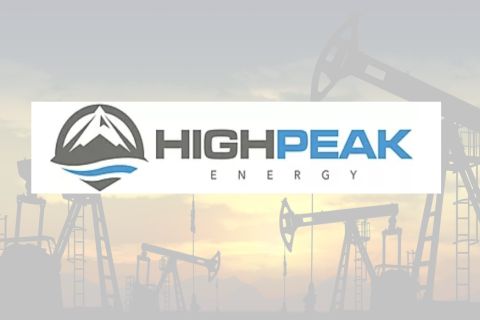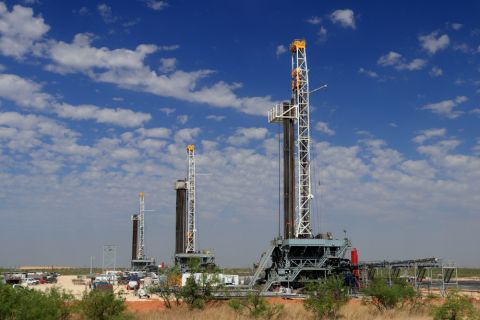
(Source: Ken Childress photography, Shutterstock)
Learn more about Hart Energy Conferences
Get our latest conference schedules, updates and insights straight to your inbox.
Technology, expressed as a blizzard of software packages, iPad apps and Internet of Things (IoT) connectivity, is the talk of the midstream nowadays. But are the sector’s operators making the fullest use of all that technology offers them?
Too often, probably not.
Many times, all that fancy, gee-whiz stuff arrives as bolt-on/duct-taped/jury-rigged additions to existing organizations and technology systems and really don’t change all that much. File folders change names, links move on computer screens and graph lines change color.
Rather, too often, differing software actually may impede, rather than improve, operations as employees struggle to adapt.
Instead, “we are fundamentally changing the way our industry approaches people, processes and technology,” Wouter van Kempen, chairman, president and CEO of DCP Midstream, told Midstream Business. The Denver-based firm, ranked No. 15 on the Midstream 50, is investing millions of dollars and thousands of staff hours in a ground-up digital transformation it calls DCP 2.0.
Different direction
The goal is to create a tech-savvy midstream firm that operates in a markedly different manner from what it was—and what many of its competitors are.
The CEO said the process began as one of senior management’s reactions to the oil and gas industry’s crash in 2015 and 2016. DCP, like most other firms in the business, endured a painful pullback that saw costly assets gathering dust and, worse, talented and loyal employees let go.
Van Kempen said having to lay off those people was the most painful part of the retrenchment for him “and I vowed to avoid that at all costs moving forward. We had to change the way we run the company.”

The energy business, like all commodity-based industries, will be cyclical forever. The fourth-quarter 2018 oil price collapse was another reminder of that fact. So what needs to happen, he added, is to build “an organization that is sustainable in any operating environment.” Technology can help make that happen, van Kempen emphasized.
“Make no mistake of viewing this as merely implementing slick apps and putting plant screens up in a control room … this is all about completely disrupting the industry,” he added.
In 2015, the CEO presented the basic concept of DCP 2.0 to the firm’s board of directors. Some directors expressed their doubts about the idea at first. After all, didn’t the firm already enjoy great technology, such as a first-class SCADA system?
What was it missing?
Wouldn’t a broad remake be disruptive?
What could 2.0 add except costs and confusion?
But van Kempen gained board approval by emphasizing the plan was not change for change’s sake but a whole new way to operate that would stabilize operations as it offered the potential for increased returns to unit holders.
“We have $13 billion of steel in the ground and we have to make sure that all of it is making money. How can we make sure we’re getting as much as we can out of what we have?” van Kempen added.
Operations, not IT
So management went to work to implement the plan. Bill Johnson became group vice president and chief transformation officer (CTO) of the project, having formerly been vice president of DCP’s North Business Unit. Believing that real priorities must receive high-level and focused attention, the new position reported directly to van Kempen. Soon after, a cadre of diverse talent, from design thinkers and app developers to so-called “scrum masters” (group facilitators) and Silicon Valley veterans, was hired to form his team.
Johnson is an operations guy, not an IT executive. He has a mechanical engineering degree from Texas A&M’s engineering school and held senior positions in engineering, operations, reliability and maintenance, turnarounds, corporate engineering and plant management at multiple chemical and refining sites before joining DCP in 2011.
In 2017, the project began in earnest, aiming to be “a transformation to achieve operational excellence through eliminating pain points and setting people up for success,” Johnson told Midstream Business. He added that 2.0 represents “a tremendous opportunity to digitize our operations and corporate functions to deliver rapid solutions resulting in higher margins, lower costs, and greater reliability.”
“The oil and gas industry is behind, and midstream is even further behind, in adopting digital technology,” Johnson said. “Producers have made some amazing technology advances downhole, but there has not been a lot of change in the above-ground operations of our assets. Innovation is something we have to do.”
But the process has to involve the entire organization, he added. It can’t be viewed as only something IT does.
“This is not an IT project, it has come out of operations. And in fact, IT now reports to me,” he said. “Similarly, our commercial and back-office functions are developing automation, bots, artificial intelligence and other digital tools that can optimize our work processes … eliminating lower-valued work and improving job satisfaction. This is about the company as a whole,” Johnson said.
Idea swaps
Significantly, DCP is looking beyond in-house and in-sector techniques that it can employ.
“We don’t need to invent something here,” van Kempen emphasized. If a given technology works for industries as diverse as, say, banks or airlines, it might have immediate application with minimal tweaks at a gas plant. The CEO noted his own career began outside midstream—he came to DCP from tech-savvy General Electric. He noted that the midstream segment’s operators can become inbred and less efficient if they are not open to outside ideas. It’s a trend all industries need to avoid, he added.
Johnson agreed.
“We got started by looking outside our industry,” he said. “Oil and gas is not a leading adopter of digital technologies. So, we went outside to look at what others are doing. We looked in retail, logistics, banking, airlines and more. We used the learnings from these visits to refine our vision and fully develop our plan.”
A new look and feel
Given that diverse background, it’s no surprise that the heart of the 2.0 program looks fundamentally different than a typical, button-downed energy company’s cube-farm headquarters.
Consider one floor of DCP’s headquarters, 23 stories above the bustling streets of downtown Denver.
Stepping off the elevator, the vibe is Silicon Valley. Bluejean-casual employees work from laptops set out on folding tables. Such groupings can be easily mixed or matched as current work projects require. Sofas and easy chairs provide nooks for impromptu meetings. “Collaboration” is a word used frequently.
It may look disorganized but it works, Johnson said, because the layout offers easy ways to communicate. DCP employed the team communications software Slack and the similar Microsoft Teams chat board to encourage the informal mixing and matching of ideas. It even implemented Facebook’s new platform, Workplace, to encourage people across its 17-state footprint to engage and accelerate the transformation.
It’s a significant departure from typical corporate, chain-of-command communication procedures, the CTO emphasized.
DCP wants to encourage “a culture of innovation” that can adopt new methods across the organization—department-to-department and plant-to-plant—enabling faster value creation, Johnson said.
In the middle of that Silicon Valley-style floor at Denver headquarters is something that looks very familiar to any midstream operations person: DCP’s Integrated Collaboration Center (ICC). At first glance it appears to be just a bigger-than-usual SCADA control room with maybe a little extra NASA space-shot stuff thrown in for good measure.
“I’ve heard some say, ‘we have SCADA,’ but SCADA as a singular approach is antiquated. SCADA is a rearview mirror, it tells you what has happened, not what will happen. We want to take millions of data points, put them together and figure what will happen, or how to do things better,” van Kempen said.
Usable data
The concept is to convert the mountains of data modern technology provides into usable information that enables real-time management decisions.
The ICC, as it name implies, allows DCP to collect and study data from throughout the organization, then its algorithms crunch that information and projects what lies ahead.
“Our ICC acts like a nucleus of several operating data sources. It is the central nervous system of our operations,” van Kempen said. “In real time we are tying together data from SCADA and engineering, over 8,000 different contracts, financial systems, and all of our real-time market prices for gas, crude and NGL—allowing us to optimize our integrated plant system, driving greater profitability and better reliability,” he added.
Ideally, it can project that a given pump at a Permian Basin processing plant is going bad. That pump may be moving as much product as ever but it’s steadily using more and more power to do it.
Why?
That’s a bad sign and worth checking. A busy operator may overlook the power usage data point—but the system won’t. The pump can be shut down and replaced or repaired before an incident occurs.
The payoff
So is 2.0 paying off? Yes, the results have been impressive, according to Johnson. But the full financial return is yet to come.
“From concept to 18 months, DCP 2.0 evolved into a function already delivering a payback equal to the tens of millions we invested in the first year,” Johnson said. “We’re continuing to build operational and financial models to drive optimization. We have opportunities in the rest of our plants, and we also have opportunities to optimize the gas in our systems, where we have large integrated systems with multiple plants.”
“There’s huge opportunity there,” he added. “It lies in getting the rest of the plants in every system into an optimization model in the ICC and continuing to fully digitize and enable our workforce across every function in the company.”
Mewbourn
Plant control rooms now match the ICC layout if on a smaller scale, and transmit real-time data between the field and headquarters. An hour’s drive northeast of Denver, operations are monitored at the firm’s Mewbourn 2 and 3 facility, built to serve Denver-Julesburg producers. Multiple computer monitors show what currently is happening in the complex—a typical SCADA function—but also what will happen, Craig Taylor, plants supervisor, told Midstream Business. He noted that much, if not all, of that information can be pulled up on an iPad or cell phone if necessary. The idea is to avoid inconvenient—and costly—callouts at 2 in the morning on holiday weekends.
The Mewbourn 3 operation is one example of what the DCP 2.0 concept can do. The new plant has a capacity to process 200 million cubic feet per day and went online in third-quarter 2018 after a remarkably short, nine-month construction and commissioning window.
Collaboration is a key to how it works, Johnson added. Separate gas plants and operating districts have a significant amount of freedom via 2.0 to develop new apps and procedures that can be shared elsewhere in the organization.
Will that hack technicians figured out at a Permian plant work at a plant in the Denver-Julesburg Basin? Maybe, maybe not—but let’s work together to find out. It’s what van Kempen calls “a culture of innovation.”
DCP put significant effort into the program throughout 2018. This year, the program is accelerating and Johnson says there has been “rapid refinement, integration and extension of transformational solutions conceived, built and delivered.”
Easy does it
So is all of this change confusing to employees? Ideally, it won’t be.
New apps, procedures and techniques should be easy to master, both van Kempen and Johnson said. New Uber customers, for example, don’t need to fly to that firm’s headquarters in San Francisco for two weeks of training, van Kempen added. Likewise, a bank doesn’t require a customer to spend days reading instruction books or watching videos after its app gets downloaded onto a cell phone.
A major 2.0 goal is to make procedures easier, faster and cheaper to operate.
Even small changes can add up quickly, Johnson noted. If DCP can figure how to save $2,500 per day at each of its 60 gas processing plants—very small potatoes for an organization with annual revenues approaching $10 billion—that can add up to $50 million per year that goes straight to the bottom line.
“We’re picking up pennies,” he added with chuckle. And all those pennies can add up to serious money. “Ultimately, the ICC gives us the ability to make impactful optimization decisions in real-time—rather than daily, weekly, or monthly—resulting in immediate improvements in our operations. Not to mention, there’s the impact of the incredible arsenal of data we are building as a foundation for predictive analytics.”
The effort already has paid off, van Kempen confirmed. DCP 2.0 provided some $20 million of incremental EBITDA in 2018, a year Johnson added was a time DCP “was transforming the end-to-end value chain.” And there is significant potential for 2019 and beyond, the executive said.
“We want to know what every plant makes [financially] every day,” van Kempen added.
2.0 and more
The technology-based effort of DCP 2.0 is part of a broader effort van Kempen orchestrated to change the firm overall known as DCP 2020.
Company literature describes DCP 2020 as “a framework for ensuring we are sustainable in any market environment. At its core, we are all focused on operational excellence in everything we do, founded on the principles of reliability, risk management and efficiency, and the behaviors of discipline, accountability and managerial courage.”
Johnson added that the 2020 effort “is about creating efficiencies that allow us to continue to reduce our costs while adding to our asset base. It’s about creating higher margins through our ICC and the integration, optimization, and collaboration around all of our data, and it’s about creating real outcomes at an unprecedented speed, delivering step changes in our reliability, safety, and customer service.
The goal of DCP 2020 is to broadly increase efficiency, creating higher margins and improved outcomes. Company executives point out that in the program’s four years, through 2018, the firm cut operating costs even as DCP’s asset base grew by $5 billion. Higher margins come via 2.0’s improved integration and real-time plant optimization.
And the outcomes? DCP gains speed and agility, improved reliability and safety marks and faster paybacks.
And overall, the firm improves profitability as it assures improved operations, whatever the commodity price environment may be.
“We’re still on a journey. DCP 2.0 is transforming our business and changing the way we work. We’ve established a culture of innovation and agility. We’re starting to create our workforce of the future and positioning DCP to accelerate or transformation. We have taken costs down, improved margins and reliability, while growing our asset base to $13 billion.” The key to success is “asset performance,” Johnson said.
“We’ve been working on this for a while now, but we still have a long way to go and a lot of opportunity in front of us, Johnson added. “We achieved a one-year payback in 2017. That is very rare for an initiative like this, with even more potential upside in the future.” The numbers are still out for 2018 but they look promising.
“Transformational changes will happen in our industry, we’ve got to jump on this quickly,” he said. “The benefit is that we can lead and be ahead of many other people in oil and gas. DCP will be a leader. This represents a huge opportunity for us, and we will lead the transformation in the midstream space.”
Recommended Reading
Comstock Continues Wildcatting, Drops Two Legacy Haynesville Rigs
2024-02-15 - The operator is dropping two of five rigs in its legacy East Texas and northwestern Louisiana play and continuing two north of Houston.
CEO: Continental Adds Midland Basin Acreage, Explores Woodford, Barnett
2024-04-11 - Continental Resources is adding leases in Midland and Ector counties, Texas, as the private E&P hunts for drilling locations to explore. Continental is also testing deeper Barnett and Woodford intervals across its Permian footprint, CEO Doug Lawler said in an exclusive interview.
For Sale, Again: Oily Northern Midland’s HighPeak Energy
2024-03-08 - The E&P is looking to hitch a ride on heated, renewed Permian Basin M&A.
TPH: Lower 48 to Shed Rigs Through 3Q Before Gas Plays Rebound
2024-03-13 - TPH&Co. analysis shows the Permian Basin will lose rigs near term, but as activity in gassy plays ticks up later this year, the Permian may be headed towards muted activity into 2025.
Evolution Petroleum Sees Progress on SCOOP/STACK, Chaveroo Operations
2024-03-11 - Evolution expects to participate in future development blocks, holding in aggregate over 70 additional horizontal well locations.





